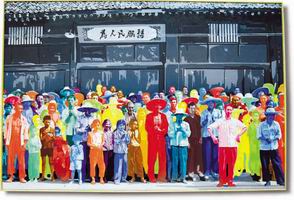Shanghai Daily news

A visitor admires Jacques Monory¡¯s ¡°Meurtre n¡ã
10/2¡± (1968).
(Photo: Shanghai Daily)

Gerard Fromanger¡¯s photo ¡°En Chine, a Hu-Xian¡±
(1974).

Bernard Rancillac¡¯s ¡°Suite Americaine¡±
(1970).
The term ¡°New Wave¡± in filmmaking is familiar to all movie fans. However, the
New Wave exhibits at the Shanghai Art Museum on loan from Centre Pompidou in
Paris won¡¯t be seen in cinemas or on DVDs.
As part of the Year of France in
China, the exhibition, entitled ¡°Nouvelle Vague,¡±consists of 13 films, 10
videos, 26 canvases, 30 photographs and seven installations.
Centre Pompidou,
established in 1971, has selected a group of representative works to promote the
French avant-garde art in China. The center, a factory-styled complex with a
glass facade, external stairs and red, blue, green external pipes on the rear
facade, is home to a large collection of artworks spanning the 20th century. New
Wave art is one of them.
To the disappointment of many locals, big names
such as Francois Truffaut, Jean- Luc Godard and Claude Chabrol ¡ª all major movie
identities who initiated the French New Wave film ¡ª have not accompanied the
exhibition to Shanghai. However, the aim of the show is not concerned with film
alone.
¡°Today, the term ¡®New Wave¡¯ is not reserved solely for trends in
filmmaking,¡± says Mao Aimin, spokeswoman for the Shanghai Art Museum. ¡°It is
more like a cultural phenomenon that has swept through all other media.¡±
As
if to prove the truth of her statement, visitors will encounter impressive
canvases covering different subjects at the exhibition. Most images are part of
a narrative ¡ª akin to a ¡°freeze frame¡± in New Wave films.
During the late
1950s and early 1960s, young filmmakers in many countries created their own New
Waves. They changed notions of how a film could be made and were motivated by a
desire to forge a new cinema. They were tired of big-budget movies with
stereotyped forms. They stressed free choice, the inability to have any rational
understanding of the universe and a sense of the absurdity of human
life.
When visitors wander around the canvases, photographs or video
installations at the ¡°Nouvelle Vague¡± exhibition, they might experience a
similar feeling with that of when viewing the films.
People are always the
central subjects. One interesting photograph, entitled ¡°En Chine, a Hu-Xian,¡±
created by Gerard Fromanger in 1974 during the artist¡¯s trip in China, captures
a glimpse of the lives of Chinese people in a small village.
The visual
effect of the picture is achieved by processing it as a negative. The upper part
of the photograph is dominated with two hues, black and ash, while the remainder
is filled with a group of Chinese urban dwellers with innocent gazes, each
¡°dyed¡± with striking colors. The dramatic switch between colors plus the slogan
in Chinese ¡ª ¡°Serve the people¡± ¡ª reveals the artist¡¯s impression of China
during the 1970s.
Thierry Kuntzel¡¯s video work, ¡°La Peinture Cubiste,¡± shot
in 1981, tells the story of a man who goes home around midnight. In order not to
disturb his wife, he gropes in the darkness in a familiar room that is crammed
with all kinds of everyday objects. However, the onceintimate environment
suddenly changes into an unknown space and all the objects are waiting to be
recognized.
The experience here derives from the visual rules inherited from
the art of the Renaissance of the 15th century but they have suddenly been
replaced by the broken, overlapping and jagged style of Cubism.
¡°That¡¯s the
mutual effect of New Wave between filmmakers and other artists,¡± says Mao. ¡°In
this exhibition, you will find that the bond in various media ¡ª apart from film
¡ª in reflecting a subject in motion is gone. No matter whether it is on canvas
or in a photograph, we are able to see a consistent scenario ¡ª sometimes it is a
rush of thought or an emotion.¡±
Based on the period in which the works were
created, the exhibition is divided into the 1960s and 1970s, the 1980s and the
1990s to today.
Art lovers who attended the 2004 Shanghai Biennale will find
some links with works at the biennale ¡°reborn¡± from the ¡°Nouvelle Vague¡±
exhibition. For example, Valerie Jouve¡¯s photo series featuring a big portrait
of a character against a backdrop of a dilapidated construction site recalls a
local artist¡¯s work depicting the back of a girl surrounded by the ruins of a
construction site.
And Jouve¡¯s ¡°Les Facades¡± photographs of a latticed
balcony filled with boxes, bicycles, old refrigerators share a surprising
similarity with the scenes of a cluster of match-boxed apartments that were
taken by a local photographer.
It seems that the mission embarked on by the
pioneers of the New Wave is still going on and now covers a wide range of media.
It has also influenced generations of artists ¡ª perhaps too much in the case of
Chinese artists.
Date: January 17-February 25, 9am-5pm
Address: 325 Nanjing Rd
W.
Admission: 20 yuan
Tel: 6327-2829



